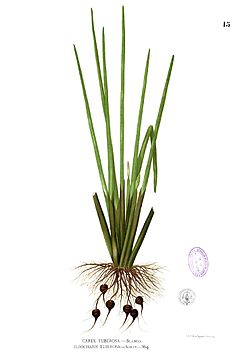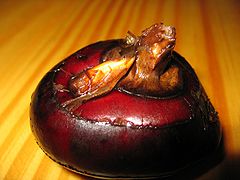
Eleocharis dulcis
Did you know...
Arranging a Wikipedia selection for schools in the developing world without internet was an initiative by SOS Children. Do you want to know about sponsoring? See www.sponsorachild.org.uk
| Water chestnut | |
|---|---|
 |
|
| Scientific classification | |
| Kingdom: | Plantae |
| Division: | Magnoliophyta |
| Class: | Liliopsida |
| Order: | Poales |
| Family: | Cyperaceae |
| Genus: | Eleocharis |
| Species: | E. dulcis |
| Binomial name | |
| Eleocharis dulcis ( Burm.f.) Trin. ex Hensch. |
|
The Chinese water chestnut (Eleocharis dulcis; synonyms E. equisetina, E. indica, E. plantaginea, E. plantaginoides, E. tuberosa, E. tumida), more often called simply the water chestnut, is a grass-like sedge grown for its edible corms. It has tube-shaped, leafless green stems that grow to about 1.5 metres. The water caltrop, which is also referred to by the same name, is unrelated and often confused with the water chestnut.
The Chinese water chestnut (traditional Chinese: 荸薺; simplified Chinese: 荸荠; hanyu pinyin: bíqí) is native to China and is widely cultivated in flooded paddy fields in southern China and parts of the Philippines.
The small, rounded corms have a crispy white flesh and can be eaten raw, slightly boiled, grilled, pickled, or tinned. They are a popular ingredient in Chinese dishes. In China, they are most often eaten raw, sometimes sweetened. They can also be ground into a flour form used for making water chestnut cake, which is common as part of dim sum cuisine. They are unusual among vegetables for remaining crisp even after being cooked or canned. They do this because their cell walls are cross-linked and strengthened by certain phenolic compounds, a property shared by other vegetables that remain crisp in this manner, including the tiger nut and lotus root.
The corms are rich in carbohydrates (about 90 percent by dry weight), especially starch (about 60 percent by dry weight), and are also a good source of dietary fibre, riboflavin, vitamin B6, potassium, copper, and manganese.
If eaten uncooked, the surface of the plants can transmit Fasciolopsiasis.

